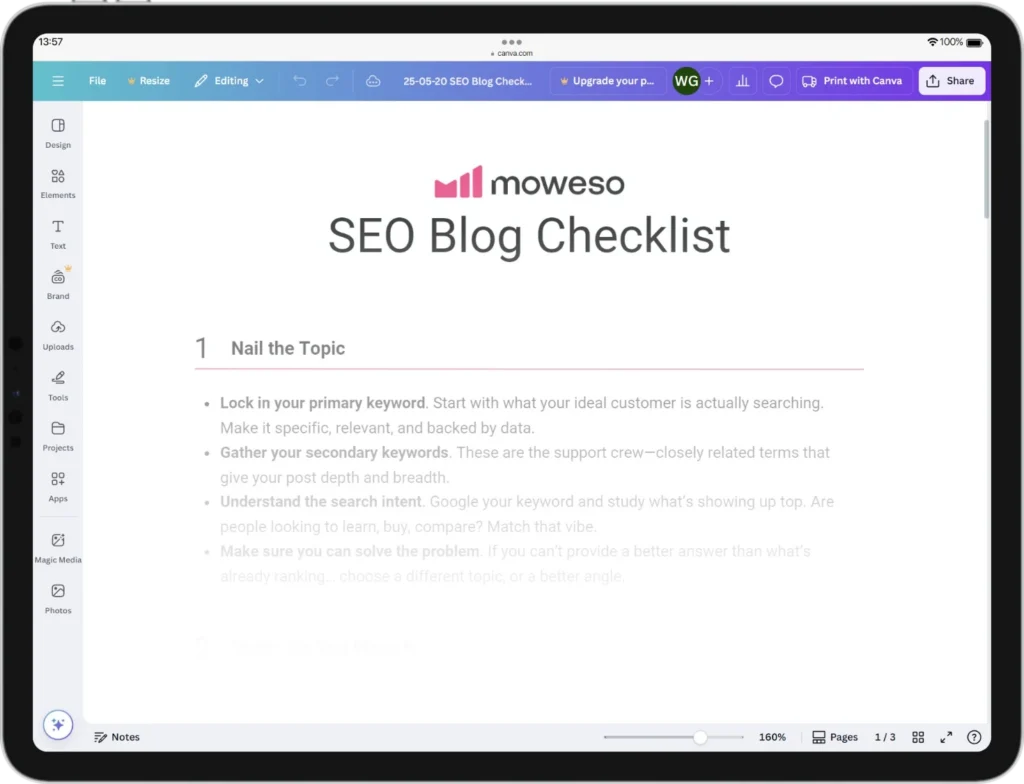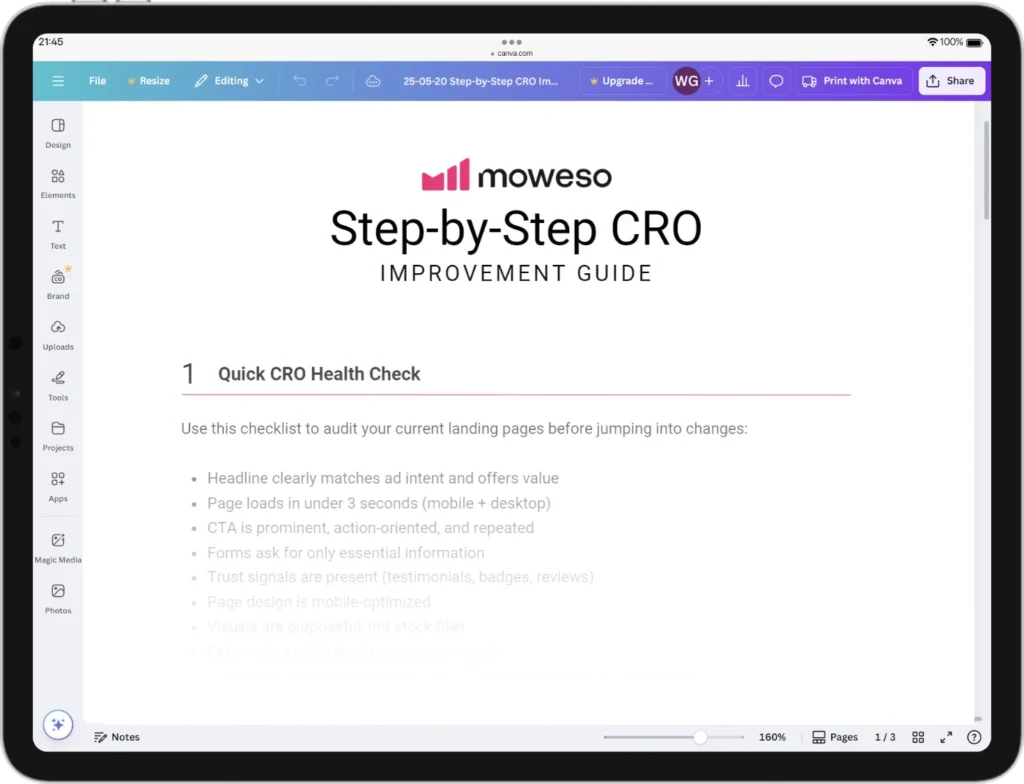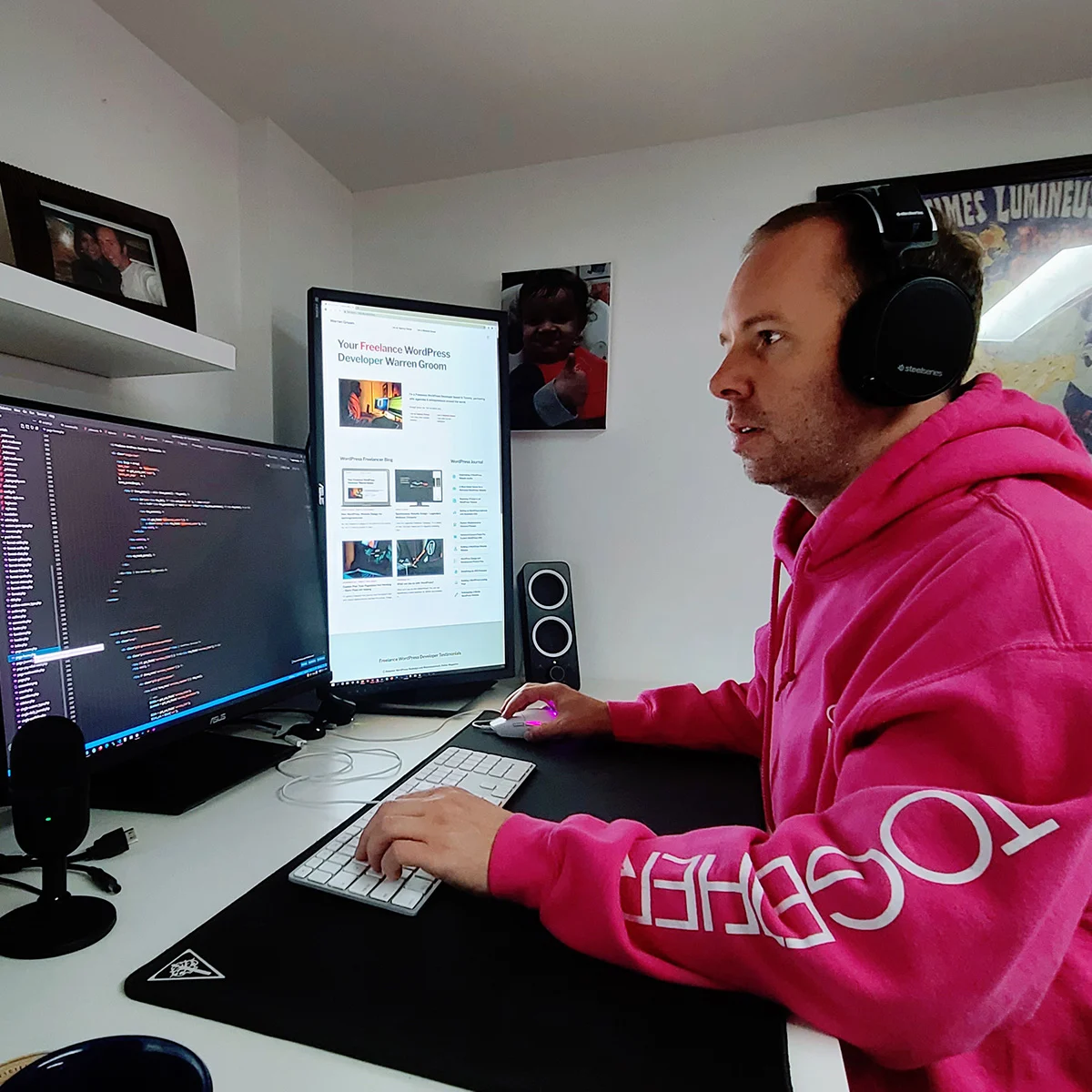Is your website holding your business back—or is it just in need of a tune-up?
If you’ve found yourself wondering whether to completely rebuild your site or simply optimize what you already have, you’re not alone. This is a critical decision point for many marketing and web teams. A full rebuild can mean starting from scratch with new tech, design, and structure. Optimization, on the other hand, focuses on improving what’s already in place.
So how do you know which path is right?
In this article, we’ll walk through the key signs that indicate a website rebuild is necessary, when optimization is enough, and how to make the smartest decision for your business. We’ll give you real-world examples, decision frameworks, and expert insights to help you choose with confidence.

SEO Blog Checklist Free Download
A practical, no-fluff SEO blog checklist built for startups and growth teams. From keyword research to AI-ready formatting and performance tracking—this guide helps you write content that ranks, resonates, and drives results.
Understanding the Difference Between Rebuilding and Optimizing
Before you decide which path to take, it’s essential to understand what “rebuilding” and “optimizing” actually mean—and what they don’t. These terms are often used interchangeably, but they involve very different scopes, timelines, and business implications.
What Does Rebuilding a Website Entail?
Rebuilding a website is essentially starting over. This process often involves:
Replatforming: Moving to a new content management system (CMS) or tech stack better suited to your current needs.
Redesigning the user interface: Overhauling the visual design and user experience from the ground up.
Restructuring the site architecture: Rethinking how content is organized, accessed, and navigated.
Rewriting content: Updating or completely replacing old copy to align with new messaging, SEO goals, or audience segments.
Rebuilding integrations: Reworking how your site connects with other systems like CRMs, marketing automation tools, or e-commerce platforms.
A rebuild is typically pursued when the current site has significant structural issues, is built on outdated technology, or simply can’t scale with your business anymore. It’s a high-investment move that aims for long-term performance, flexibility, and user engagement.
What Does Website Optimization Involve?
Optimization is more like renovating a house than rebuilding it. You’re keeping the core framework intact but enhancing individual elements to improve performance, usability, or conversions. It can include:
Improving page load speeds: Compressing images, minifying code, and reducing server response times.
Refining on-page SEO: Updating meta titles, descriptions, headers, and internal links to align with search best practices.
Enhancing UX/UI: Tweaking design elements like CTAs, menus, or mobile layouts for better usability.
Content updates: Refreshing blog posts, updating outdated stats, or adding FAQs to capture more search traffic.
Tracking and testing: Running A/B tests, improving analytics setups, and optimizing for conversion rate.
Unlike a rebuild, optimization is iterative. It’s about making targeted improvements over time to boost ROI without disrupting the entire system.
The Key Differences in a Nutshell
| Feature | Website Rebuild | Website Optimization |
|---|---|---|
| Scope | Comprehensive overhaul | Targeted improvements |
| Timeline | Weeks to months | Ongoing or short sprints |
| Cost | High investment | Typically lower, incremental costs |
| Risk | Higher (big changes, potential downtime) | Lower (small, controlled updates) |
| Goal | Long-term scalability, new direction | Performance gains, UX tweaks, SEO lifts |
Signs It’s Time to Rebuild Your Website
Rebuilding your website isn’t a small decision—it’s a major investment of time, budget, and resources. But in many cases, it’s the smartest move you can make. If your website is showing any of the signs below, a rebuild might be not only justified, but necessary.

1. Your Website Looks Visibly Outdated
If your site still looks like it belongs in the 2010s, it could be undermining your credibility. Design trends evolve rapidly, and users expect a clean, modern aesthetic that reflects your brand’s professionalism.
Red flags:
Cluttered layouts or low-res images
Outdated typography or color schemes
Non-responsive design (see next point)
Modern users judge websites within seconds—if your site feels old, they may assume your services or products are too.
2. It’s Not Mobile-Friendly
With mobile traffic accounting for over 50% of web visits globally, a mobile-unfriendly site is a major liability. Google also prioritizes mobile usability in its ranking algorithm.
What to look for:
Difficult navigation or layout issues on mobile
Text that’s hard to read without zooming
Touch elements (like buttons or links) too small to use comfortably
If fixing mobile issues means overhauling multiple templates and breaking old code, it’s often smarter to rebuild using a mobile-first framework.
3. Your Site Is Painfully Slow
Website speed is more than a user experience issue—it directly affects bounce rate, conversion rate, and SEO.
Common culprits:
Bloated, outdated codebases
Lack of caching or CDN integration
Unoptimized images and scripts
Clunky themes or legacy plugins
If your load times can’t be fixed with optimization alone, it may be time to rebuild with performance in mind from the ground up.
4. Your CMS or Tech Stack Is Holding You Back
Your content management system should empower your marketing team—not force them to jump through hoops.
Symptoms of a limiting CMS:
Frequent plugin conflicts or security issues
No support for modern features (e.g., headless CMS, multilingual content)
Inability to make simple edits without a developer
Poor scalability for future growth
If your team dreads making updates or your tech stack can’t support future goals, it’s time to move on.
If your site technically works but still feels like it’s fighting against your team’s goals, it may be worth rethinking its foundation. Your Website Isn’t Broken—It’s Just Not Built for Growth breaks down this idea in more depth.
5. You're Facing Persistent SEO and Indexing Problems
Old websites often come with outdated URL structures, poor internal linking, and thin or duplicate content—all of which can hurt your search rankings.
Technical SEO issues that may require a rebuild:
Crawl errors or blocked resources
Non-secure (HTTP) pages
Lack of schema markup
Poor Core Web Vitals scores
Complicated navigation structures
Sometimes, fixing technical SEO issues on a legacy site can take more effort than starting fresh.
6. Security Risks Are Increasing
Older websites can become security liabilities, especially if they rely on outdated plugins or themes no longer maintained by developers.
Security warning signs:
Frequent malware alerts or breaches
Manual plugin/theme updates
No SSL encryption
Difficulty adding security headers or patches
A rebuild lets you implement modern security best practices from day one, reducing your risk of hacks and data breaches.
Indicators That Optimization Is Sufficient
Not every website needs a full rebuild. In many cases, especially if the foundation is solid, targeted optimization can deliver impressive results at a fraction of the cost and effort. Here’s how to tell when your site just needs some tuning—not a teardown.

Step-by-Step CRO Improvement Guide
Turn more clicks into customers. This step-by-step CRO guide shows you how to optimize landing pages, lower CPA, and boost conversions with proven strategies, checklists, and test ideas—designed for growth-driven teams.
1. Your Website Design Still Looks Modern and Functional
If your design holds up visually, loads well on mobile, and aligns with your brand, there’s no need to reinvent the wheel. Many performance and usability gains can be achieved through small, strategic design updates.
Optimization opportunities:
Refreshing imagery or updating typography
Modernizing CTAs and buttons for better conversions
Improving visual hierarchy for easier scanning
Refining accessibility features for inclusivity
You don’t have to start over if your design still does its job effectively.
Even with a solid visual design, small changes can have a big impact. See 7 Elements That Make a B2B Website Convert for ideas on what to tweak first.
2. Your Site Structure and CMS Are Still Serving You
If your content management system is stable, secure, and user-friendly, optimization becomes the better choice. A solid CMS can support continuous improvement without requiring a full migration.
When to optimize:
You can easily update or add content
You’re not facing major plugin or integration issues
Your CMS supports your current and near-future needs
Minor template updates can enhance performance
Think of it as remodeling a house instead of demolishing it.
3. SEO Is Solid—but Has Room to Grow
If your site is already ranking for key terms and getting organic traffic, you likely don’t want to risk a complete overhaul that could hurt your SEO momentum.
What to optimize:
On-page SEO (titles, meta descriptions, internal linking)
Updating blog posts and cornerstone content
Adding schema markup for rich results
Fixing minor technical SEO issues (like broken links or redirects)
Improving image alt text and file naming for visual search
SEO thrives on iteration. Focus on improving what’s working rather than wiping the slate clean.
4. Speed and Performance Can Be Incrementally Improved
If your site isn’t slow enough to send users packing but could use a performance boost, targeted optimizations often get the job done.
Quick wins:
Image compression and lazy loading
Minifying CSS, JS, and HTML
Leveraging browser caching and a CDN
Reducing third-party scripts
Tools like Google PageSpeed Insights and GTmetrix can help identify specific areas to fine-tune without a full rebuild.
5. You’re Focused on Conversion Rate Optimization (CRO)
If specific landing pages are underperforming, that doesn’t mean your entire website is broken. Try optimizing those areas first — here’s how to fix a landing page that isn’t converting.
If your primary goal is to increase leads, sales, or signups, optimization allows you to test and refine without disrupting the entire user experience.
Effective CRO tactics:
A/B testing CTAs and layouts
Improving form usability
Adjusting navigation for clearer paths to conversion
Adding trust signals like testimonials or case studies
A rebuild resets everything. Optimization lets you improve incrementally based on real user behavior.
If your site is already driving traffic but conversions are lagging, you might not need a rebuild—just sharper CRO. Learn more in Why Your Website Gets Traffic but No Leads.
6. Your Budget and Timeline Are Limited
Sometimes, optimization is the only feasible option—especially for smaller teams or startups. That doesn’t mean settling. It means prioritizing high-impact improvements over perfection.
Examples of low-cost, high-return fixes:
Updating outdated copy
Fixing broken links or 404 errors
Improving mobile spacing and touch targets
Simplifying navigation
Focus on what delivers value now, while planning for a future rebuild when resources allow.
Decision-Making Framework
Still not sure whether to rebuild or optimize? Use this structured decision-making framework to evaluate your current website against your goals, resources, and risks. It’s not just about what’s broken—it’s about what’s holding you back from growing.

1. Align With Your Business Goals
Start by zooming out: What does your website need to do for your business over the next 12–24 months?
Ask yourself:
Are you targeting a new audience or launching new products?
Do you need to scale content creation or integrate new tools?
Is your website a core part of your lead generation or sales funnel?
If your current website can’t support where you’re going, a rebuild may be the better investment—even if it’s technically “working” right now.
If your business is scaling quickly, you need a site (and an SEO plan) that grows with it. Here’s our breakdown of what to focus on (and what to skip) in SEO for scaling startups.
2. Evaluate Technical Debt and Scalability
Technical debt—outdated code, messy integrations, hardcoded content—can quietly strangle your ability to move fast. If your dev team spends more time patching than building, you’re overdue for a change.
Look for these red flags:
You rely on custom workarounds for basic functionality
New features take too long or cost too much to implement
Developers avoid touching parts of your codebase
You can’t easily scale to support new features or growth
A rebuild allows you to modernize your architecture, choose a scalable CMS, and future-proof your stack.
3. Consider the Total Cost of Ownership
Website decisions aren’t just about upfront costs—they’re about ongoing returns. Optimization may seem cheaper, but if it’s dragging out over months with limited impact, you may be better off rebuilding once and reaping longer-term gains.
Compare:
| Factor | Rebuild | Optimization |
|---|---|---|
| Upfront cost | High | Low to moderate |
| Time to complete | Long (weeks/months) | Short sprints |
| Long-term flexibility | High | Limited by current structure |
| ROI timeline | Slower start, longer upside | Quick wins, but plateau faster |
| Risk of disruption | Higher (requires full migration) | Low (incremental changes) |
Calculate the ROI not just in budget, but in time saved, capabilities unlocked, and traffic or revenue potential gained.
4. Factor In SEO Risk
If your website has strong organic rankings, a full rebuild needs to be approached carefully. Migrations done wrong can tank SEO.
Before you rebuild:
Conduct a full SEO audit
Map 301 redirects for all URL changes
Preserve high-performing content and structure
Test everything in staging before launching
If SEO is fragile and you don’t have the resources for a careful migration, it may be safer to optimize until you’re fully prepared.
5. Assess Internal Readiness
Finally, look at your team’s bandwidth and buy-in. A rebuild requires alignment between marketing, dev, and leadership. Without it, the process can stall—or fail.
Checklist for rebuild readiness:
You have clear goals and ownership across teams
You’ve set a realistic timeline and budget
You can allocate resources for planning, content, and testing
You’re ready to pause minor optimizations and focus fully
If you’re not quite there, use optimization as a stepping stone—improving what you can now while laying the groundwork for a rebuild down the line.
Conclusion: Making the Right Choice for Your Website
Whether you rebuild or optimize, the key is making a decision rooted in strategy—not stress.
If your website is fundamentally limiting your growth, riddled with performance issues, or simply too outdated to serve your goals, a rebuild can unlock entirely new potential. But if your foundation is solid and your goals are focused on performance gains, lead generation, or small UX wins, optimization can deliver fast, efficient results without a full overhaul.
Think of your website like a business asset—it should evolve with your company, support your goals, and adapt to your audience’s needs. And if it’s not doing that, it’s time to ask why.

